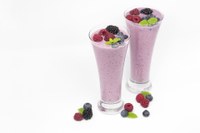Prairie Fare: Will the real milk stand up?
(Click an image below to view a high-resolution image that can be downloaded)
By Julie Garden-Robinson, food and nutrition specialist
NDSU Extension
As I picked up milk at the grocery store one day, I noticed many milk-like beverages beckoning me in their direction with their assorted packaging designs.
In some grocery stores, we have several nut-, seed- or grain-based milk-like beverages available. Almond, coconut, cashew, hazelnut, hemp, soy, oat and rice-based plant beverages are among the beverages available.
Why are so many milk-like beverages available?
People make food choices for many reasons, including taste, price and dietary restrictions. We have thousands of choices in large supermarkets as a result.
Those following a vegetarian or vegan diet enjoy having several plant-based choices available. Vegans consume only plant-based foods, while “lacto-vegetarians” consume dairy products as part of an overall plant-based diet.
Those who are allergic to dairy protein need to obtain their calcium and other nutrients from other sources. People with “lactose intolerance” are sensitive to lactose, the natural sugar in milk, although they may tolerate dairy milk when consumed with meals.
Other people discuss environmental impact, including water use in producing both plant- and animal-based milks.
The milk-like beverages in my line of sight at the grocery store were not technically “milk.” According to its legal definition, “milk” is obtained from healthy cows.
Here’s the legal definition of milk: “Milk means the lacteal secretion, practically free from colostrum, obtained by the complete milking of one or more healthy cows, which may be clarified and may be adjusted by separating part of the fat therefrom; concentrated milk, reconstituted milk, and dry whole milk.”
Why drink milk of any kind, anyway? Our beverages can provide nutrients to sustain our health.
We all need a full complement of nutrients from a variety of food sources.
Milk-like beverages vary in their nutritional value and the length of their ingredient statements. Some milk-like beverages have long ingredient lists of added vitamins and minerals.
Some plant-based milks are much lower in protein and some cost more.
On the other hand, some plant-based milks are lower in calories and natural sugars than others.
Be an informed consumer regardless of what you choose to buy and consume. The information on a food product label is regulated to be accurate. Read and compare both the ingredient statements and the nutrition label on the products.
In full disclosure, I primarily consume dairy milk because I like the taste, texture, cooking properties and nutritional qualities.
However, if I were offered other milk-like beverages at someone’s home, I would consume those too.
Dairy milk provides nearly 30% of the daily recommendation for calcium and 8 grams of protein per cup. It also provides the B vitamins riboflavin, thiamine and vitamin B-12, along with the minerals potassium, phosphorus and selenium.
Milk is fortified with vitamin A and D as public health measures. Vitamin A helps maintain healthy eyes and skin, while vitamin D helps maintain healthy bones, among its many functions. Milk also provides magnesium and zinc.
Soy milk is fairly close in nutrition to cow’s milk. Infants who cannot tolerate milk-based formula often are switched to soy formulas.
On average, from ages 9 through adulthood, males and females need about 3 cups of dairy, or the nutritional equivalent, daily according to the U.S. Dietary Guidelines for Americans. Toddlers need and young children need about 2 to 2 ½ cups daily.
According to market research, households purchased more milk and other dairy products online in 2020 than in 2019, with an increase of 200% between March and August 2020.
U.S. Department of Agriculture data showed that people consumed 3 pounds more dairy products in 2020 compared to 2019. In fact, dairy product consumption has increased 27 pounds per person in the last five years.
People were cooking and baking at home more during the pandemic. Milk-based foods tend to be comforting.
Here’s a portable breakfast in a cup.
Berry Fusion Smoothie
1/2 cup plain milk or soy milk
1/2 cup apple juice
1/2 cup raspberries
1/2 cup blueberries
3 teaspoons honey, to taste
½ cup ice
Combine all ingredients in blender and blend until smooth. You can swap in your favorite berries. Serve chilled.
Makes one serving. Each serving has 220 calories, 2.5 g fat, 5 g protein, 53 g carbohydrate, 3 g fiber and 65 mg sodium.
(Julie Garden-Robinson, Ph.D., R.D., L.R.D., is a North Dakota State University Extension food and nutrition specialist and professor in the Department of Health, Nutrition and Exercise Sciences. Follow her on Twitter @jgardenrobinson)
NDSU Agriculture Communication – June 9, 2022
Source: Julie Garden-Robinson, 701-231-7187, julie.garden-robinson@ndsu.edu
Editor: Elizabeth Cronin, 701-231-5391, elizabeth.cronin@ndsu.edu




